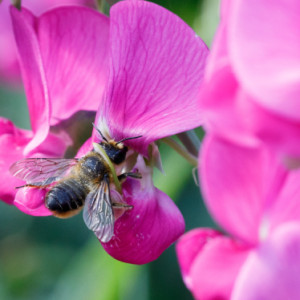Big-headed
Today was hot and sunny - though nowhere near as hot as the next three days are expected to be - and I turned my back very firmly on all the work that was waiting for me in the house, and sat reading in the shade of the trees down in the wild garden for most of the day. Consequently I don't have any news to share this evening, but I do have two bees to offer from the short sessions I spent from time to time strolling around with the camera.
The main image is Osmia leaiana, the orange-vented mason bee, on a thistle at Tilly's field. You may remember how pleased I was with myself when I spotted a couple of fresh male specimens a few weeks ago; this, for completeness, is a female. This is one of a few species of solitary bee in which the female's pollen brush is underneath the abdomen rather than on the hind legs, and I confess that I have difficulty telling them apart unless I happen to see them in close proximity. When I was photographing this one I assumed that she was a Megachile leaf-cutter bee, because my garden is currently full of them, and it was only when I uploaded my photos this evening that I saw my mistake. However, Falk says that O. leaiana resembles a big-headed Megachile in the field, and that makes me feel a little better.
For comparison, my extra is a Megachile from the garden - probably Megachile willughbiella, because I think I can see that her pollen brush is black towards the tip of her abdomen, rather than M. centuncularis, in which the brush is completely orange. If you flick between the images you'll see the superficial similarity between them, but if you saw these bees together on the same plant you'd be struck by the difference in size: the Osmia is around a centimetre in length, but the Megachile is around 1.5cm long, and correspondingly broader and heavier. Their flight periods are essentially the same - May/June through into August - and both species nest in a variety of habitats, including gardens. One significant difference though, is that M. willughbiella will forage from a variety of flowers, including my perennial pea, whereas O. leaiana will only take pollen from Asteraceae, and though it's said to exploit various kinds of daisies, in this village I've only ever seen it on thistles and knapweed.


Comments
Sign in or get an account to comment.


